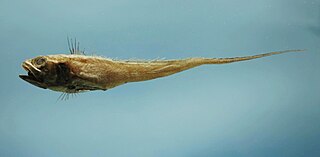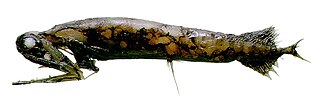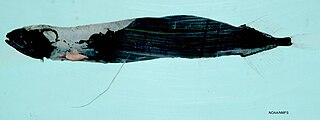
Stomiiformes is an order of deep-sea ray-finned fishes of very diverse morphology. It includes, for example, dragonfishes, lightfishes, loosejaws, marine hatchetfishes and viperfishes. The order contains 4 families with more than 50 genera and at least 410 species. As usual for deep-sea fishes, there are few common names for species of the order, but the Stomiiformes as a whole are often called dragonfishes and allies or simply stomiiforms.

Macroudidae is a family of deep sea fish, a diverse and ecologically important group, which are part of the order of cod-like fish, the Gadiformes. The species in the Macrouridae are characterised by their large heads which normally have a single barbel on the chin, projecting snouts, and slender bodies that taper to whip-like tails, without an obvious caudal fin but what there is of the caudal fin is often confluent with the posterior dorsal and anal fins. There are normally two dorsal fins, the anterior dorsal fin is quite high, the posterior quite low but is longer and takes up a greater proportion of the fish's of the back, species in the subfamily Macrouroidinae have a single dorsal fin. The long anal fin is almost as long as the second dorsal fin is nearly as long as the posterior dorsal, and sometimes it is longer. The pelvic fin is inserted in the vicinity of the thorax and normally has 5-17 fin rays but are absent in Macrouroides. The body is covered in small scales and if they have a photophore, it is usually on the midline of the abdomen just in front of the anus. The bioluminescence of these fish is produced by symbiotic bioluminescent bacteria. The structure of the skull has been used to show their placing in the Gadiformes, but they differ from the typical cods in that they possess one stout spine in the anterior dorsal fin.

The footballfish form a family, Himantolophidae, of globose, deep-sea anglerfishes found in tropical and subtropical waters of the Atlantic, Indian, and Pacific Ocean. The family contains c. 22 species all in a single genus, Himantolophus.

A viperfish is any species of marine fish in the genus Chauliodus. Viperfish are characterized by long, needle-like teeth and hinged lower jaws. A typical viperfish grows to lengths of 30 to 60 cm. Viperfish stay near lower depths in the daytime and shallower depths at night, primarily in tropical and temperate waters. Viperfish are believed to attack prey after luring them within range with light-producing organs called photophores, which are located along the ventral sides of its body, and with a discrete photophore at the end of a long spine in the dorsal fin reminiscent of the illicium of the unrelated deep-sea anglerfishes. The viperfish flashes this natural light on and off, at the same time moving its dorsal spine around like a fishing rod and hanging completely still in the water.

Stomiidae is a family of deep-sea ray-finned fish, including the barbeled dragonfishes. They are quite small, usually around 15 cm, up to 26 cm. These fish are apex predators and have enormous jaws filled with fang-like teeth. They are also able to hinge the neurocranium and upper-jaw system, which leads to the opening of the jaw to more than 100 degrees. This ability allows them to consume extremely large prey, often 50% greater than their standard length.

Malacosteus niger is a species of fish in the family Stomiidae, the barbeled dragonfishes. It is known by the common names northern stoplight loosejaw, lightless loosejaw, black loosejaw, and black hinged-head. It lives in oceans around the world from tropical to subarctic waters where it feeds primarily on zooplankton, but is also known to consume piscivores. Its unique visual and bioluminescence permit it to see the red light produced by its photophores which most other species cannot perceive, thus making M. niger an apex predator in its ecosystem.

Sloane's viperfish, Chauliodus sloani, is a predatory, mesopelagic dragonfish found in deep-pelagic waters across the world. The species was first described by German scientists Marcus Elieser Bloch and Johann Gottlob Schneider in their 1801 book Systema ichthyologiae: iconibus CX illustratum, volume 1. Its size can range from 64 mm to 260 mm, and it is an iridescent silver-blue color. It has two rows of photophores, one on each side of the ventral part of its body. It is believed that C. sloani adjusts the intensity of ventral photophores during diurnal migrations to camouflage itself from predators that might see its shadow from below.
Eustomias trewavasae, the deepsea dragonfish, is a small abyssal barbeled dragonfish of the family Stomiidae, found worldwide in tropical and subtropical oceans at depths down to 1,500 m. Its length is up to 26 centimetres (10 in) TL.
The scaly dragonfish or boa dragonfish, is a medium-sized abyssal barbeled dragonfish of the family Stomiidae. It is found at great depths worldwide in tropical to temperate oceans but is absent from the northern Pacific and northwest Atlantic Oceans.
Malacosteus australis, the southern stoplight loosejaw, is a species of barbeled dragonfish. This species is mainly distinguished from Malacosteus niger by a smaller postorbital photophore in both sexes and lower numbers of lateral photophores. It also differs in having somewhat smaller jaws, a fleshy orbit, and several subtle morphological traits. The maximum known length is 253.2 cm. Its specific epithet comes from the Latin austral, meaning "southern". It is known for its red bioluminescence which helps M. australis visualize in the aphotic deep sea.
Scaleless dragonfish may refer to:

Bathophilus is a genus of barbeled dragonfishes native to the ocean depths of the Pacific, Atlantic and Indian oceans.
Echiostoma barbatum, the Threadfin dragonfish, is a species of barbeled dragonfish and is the only known species in its genus. It is widespread through tropical to temperate waters in all oceans in mid to deep waters up to 2,000 metres (6,600 ft). This species grows to a length of 36.8 centimetres (14.5 in) SL.
Eustomias is a genus of barbeled dragonfishes native to the oceanic depths of the Indian, Atlantic and Pacific oceans.

Idiacanthus is a genus of barbeled dragonfishes, the larvae of which are noted for exhibiting the Stylophthalmine trait.
Melanostomias is a genus of barbeled dragonfishes.
Photonectes is a genus of fish in the family Stomiidae found in Atlantic, Indian and Pacific Ocean.
Grammatostomias flagellibarba is a species of barbeled dragonfish. They live at depths of up to 1,500 m below the surface and usually measure up to 15.2 cm in length.
Astronesthes richardsoni, or Richardson's snaggletooth, is a species of small, deep sea fish in the family Stomiidae. It occurs in the tropical western Atlantic Ocean, the Caribbean Sea and the Gulf of Mexico. First described by the Cuban zoologist Felipe Poey in 1852, it was named Chauliodus richardsoni in honour of the Scottish explorer and naturalist John Richardson. It was later transferred to the genus Astronesthes.
Stomias affinis, also known as Gunther's boafish, is a deep-sea mesopelagic fish species in the family Stomiidae. They inhabit the open seas in the equatorial zones of the Atlantic, Indian and Pacific Oceans.








